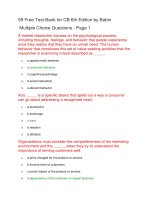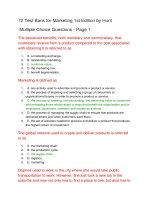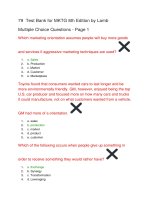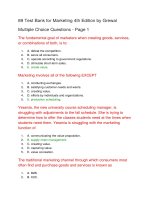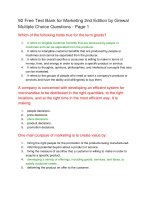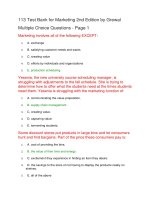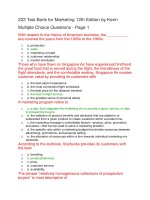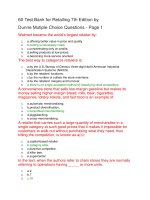Test bank for investments global edition 10th edition by zvi bodie
Bạn đang xem bản rút gọn của tài liệu. Xem và tải ngay bản đầy đủ của tài liệu tại đây (470.65 KB, 73 trang )
Test Bank for Investments Global Edition 10th
Edition by Bodie
Chapter 02
Asset Classes and Financial Instruments
Multiple Choice Questions
1. Which of the following is not a characteristic of a money market instrument?
A. Liquidity
B. Marketability
C. Long maturity
D. Liquidity premium
E. Long maturity and liquidity premium
2. The money market is a subsector of the
A. commodity market.
B. capital market.
C. derivatives market.
D. equity market.
E. None of the options
3. Treasury Inflation-Protected Securities (TIPS)
A. pay a fixed interest rate for life.
2-1
B. pay a variable interest rate that is indexed to inflation, but maintain a constant principal.
C. provide a constant stream of income in real (inflation-adjusted) dollars.
D. have their principal adjusted in proportion to the Consumer Price Index.
E. provide a constant stream of income in real (inflation
-adjusted) dollars and have their
principal adjusted in proportion to the Consumer Price Index.
4. Which one of the following is not a money market instrument?
A. Treasury bill
B. Negotiable certificate of deposit
C. Commercial paper
D. Treasury bond
E. Eurodollar account
5. T-bills are financial instruments initially sold by ________ to raise funds.
A. commercial banks
B. the U.S. government
C. state and local governments
D. agencies of the federal government
E. the U.S. government and agencies of the federal government
6. The bid price of a T-bill in the secondary market is
A. the price at which the dealer in T -bills is willing to sell the bill.
B. the price at which the dealer in T -bills is willing to buy the bill.
2-2
C. greater than the asked price of the T-bill.
D. the price at which the investor can buy the T-bill.
E. never quoted in the financial press.
7. The smallest component of the money market is
A. repurchase agreements.
B. small
-denomination time deposits.
C. savings deposits.
D. money market mutual funds.
E. commercial paper
8. The smallest component of the bond market is _______ debt.
A. Treasury
B. other asset-backed
C. corporate
D. tax-exempt
E. mortgage-backed
9. The largest component of the bond market is _______ debt.
A. Treasury
B. asset-backed
C. corporate
D. tax-exempt
2-3
E. mortgage-backed
10. Which of the following is not a component of the money market?
A. Repurchase agreements
B. Eurodollars
C. Real estate investment trusts
D. Money market mutual funds
E. Commercial paper
11. Commercial paper is a short-term security issued by ________ to raise funds.
A. the Federal Reserve Bank
B. commercial banks
C. large, well-known companies
D. the New York Stock Exchange
E. state and local governments
12. Which one of the following terms best describes Eurodollars?
A. Dollar-denominated deposits only in European banks.
B. Dollar-denominated deposits at branches of foreign banks in the U.S.
C. Dollar-denominated deposits at foreign banks and branches of American banks outside the
U.S.
D. Dollar-denominated deposits at American banks in the U.S.
E. Dollars that have been exchanged for European currency.
13. Deposits of commercial banks at the Federal Reserve Bank are called
2-4
A. bankers' acceptances.
B. repurchase agreements.
C. time deposits.
D. federal funds.
E. reserve requirements.
14. The interest rate charged by banks with excess reserves at a Federal Reserve Bank to banks
needing overnight loans to meet reserve requirements is called the
A. prime rate.
B. discount rate.
C. federal funds rate.
D. call money rate.
E. money market rate.
15. Which of the following statement(s) is(are) true regarding municipal bonds?
I) A municipal bond is a debt obligation issued by state or local governments. II) A
municipal bond is a debt obligation issued by the federal government.
III) The interest income from a municipal bond is exempt from federal income taxation. IV) The
interest income from a municipal bond is exempt from state and local taxation in the issuing
state.
A. I and II only
B. I and III only
C. I, II, and III only
D. I, III, and IV only
2-5
E. I and
IV only
16. Which of the following statements is true regarding a corporate bond?
A. A corporate callable bond gives the holder the right to exchange it for a specified number of
the company's common shares.
B. A corporate debenture is a
secured bond.
C. A corporate indenture is a secured bond.
D. A corporate convertible bond gives the holder the right to exchange the bond for a specified
number of the company's common shares.
E. Holders of corporate bonds have voting rights in the company.
17. In the event of the firm's bankruptcy
A. the most shareholders can lose is their original investment in the firm's stock.
B. common shareholders are the first in line to receive their claims on the firm's assets.
C. bondholders have claim to what is left from the liquidation of the firm's assets after paying the
shareholders.
D. the claims of preferred shareholders are honored before those of the common shareholders.
E. the most shareholders can lose is their original investment in the firm's stock and the claims of
preferred shareholders are honored before those of the common shareholders.
18. Which of the following is true regarding a firm's securities?
A. Common dividends are paid before preferred dividends.
B. Preferred stockholders have voting rights.
C. Preferred dividends are usually cumulative.
D. Preferred dividends are contractual obligations.
2-6
E. Common dividends usually can be paid if preferred dividends have been skipped.
19. Which of the following is true of the Dow Jones Industrial Average?
A. It is a value-weighted average of 30 large industrial stocks.
B. It is a price-weighted average of 30 large industrial stocks.
C. The divisor must be adjusted for stock splits.
D. It is a value-weighted average of 30 large industrial stocks and the divisor must be adjusted
for stock splits.
E. It is a price-weighted average of 30 large industrial stocks and the divisor must be adjusted for
stock splits.
20. Which of the following indices is(are) market-value weighted?
I) The New York Stock Exchange Composite Index
II) The Standard and Poor's 500 Stock Index
III) The Dow Jones Industrial Average
A. I only
B. I and II only
C. I and III only
D. I, II, and III
E. II and III only
21. The Dow Jones Industrial Average (DJIA) is computed by
A. adding the prices of 30 large "blue
-chip" stocks and dividing by 30.
B. calculating the total market value of the 30 firms in the index and dividing by 30.
C. adding the prices of the 30 stocks in the index and dividing by a divisor.
D. adding the prices of the 500 stocks in the index and dividing by a divisor.
2-7
E. adding the prices of the 30 stocks in the index and dividing by the
stocks as of some base date period.
value of these
22. Consider the following three stocks:
The price-weighted index constructed with the three stocks is
A. 30.
B. 40.
C. 50.
D. 60.
E. 70.
23. Consider the following three stocks:
The value-weighted index constructed with the three stocks using a divisor of 100 is
A. 1.2.
B. 1200.
C. 490.
D. 4900.
E. 49.
2-8
24. Consider the following three stocks:
Assume at these prices that the value-weighted index constructed with the three stocks is 490.
What would the index be if stock B is split 2 for 1 and stock C 4 for 1?
A. 265
B. 430
C. 355
D. 490
E. 1000
25. The price quotations of Treasury bonds in the Wall Street Journal show an ask price of 104:08
and a bid price of 104:04. As a buyer of the bond, what is the dollar price you expect to pay?
A. $1,048.00
B. $1,042.50
C. $1,044.00
D. $1,041.25
E. $1,040.40
26. The price quotations of Treasury bonds in the Wall Street Journal show an ask price of 104:08
and a bid price of 104:04. As a seller of the bond what is the dollar price you expect to pay?
A. $1,048.00
B. $1,042.50
2-9
C. $1,041.25
D. $1,041.75
E. $1,040.40
27. An investor purchases one municipal and one corporate bond that pay rates of return of 8% and
10%, respectively. If the investor is in the 20% marginal tax bracket, his or her after-tax rates of
return on the municipal and corporate bonds would be ________ and ______, respectively.
A. 8 % and 10%
B. 8 % and 8%
C. 6.4% and 8%
D. 6.4% and 10%
E. 10
% and 10%
28. An investor purchases one municipal and one corporate bond that pay rates of return of 7.5%
and 10.3%, respectively. If the investor is in the 25% marginal tax bracket, his or her after-tax
rates of return on the municipal and corporate bonds would be ________ and ______,
respectively.
A. 7.5
% and 10.3%
B. 7.5
% and 7.73%
C. 5.63% and 7.73%
D. 5.63% and 10.3%
E. 10
% and 10%
29. If a Treasury note has a bid price of $975, the quoted bid price in the Wall Street Journal would
be
A. 97:50.
B. 97:16.
2-10
C. 97:80.
D. 94:24.
E. 97:75.
30. If a Treasury note has a bid price of $995, the quoted bid price in the Wall Street Journal would
be
A. 99:50.
B. 99:16.
C. 99:80.
D. 99:24.
E. 99:32.
31. In calculating the Standard and Poor's stock price indices, the adjustment for stock split occurs
A. by adjusting the divisor.
B. automatically.
C. by adjusting the numerator.
D. quarterly, on the last trading day of each quarter.
32. Which of the following statements regarding the Dow Jones Industrial Average (DJIA) is false?
A. The DJIA is not very representative of the market as a whole.
B. The DJIA consists of 30 blue chip stocks.
C. The DJIA is affected equally by changes in low- and high-priced stocks.
D. The DJIA divisor needs to be adjusted for stock splits.
2-11
E. The value of the DJIA is much higher than individual stock prices.
33. The index that includes the largest number of actively traded stocks is
A. the NASDAQ Composite Index.
B. the NYSE Composite Index.
C. the Wilshire 5000 Index.
D. the Value Line Composite Index.
E. the Russell Index.
34. A 5.5% 20-year municipal bond is currently priced to yield 7.2%. For a taxpayer in the 33%
marginal tax bracket, this bond would offer an equivalent taxable yield of
A. 8.20%.
B. 10.75%.
C. 11.40%.
D. 4.82%.
35. If the market prices of each of the 30 stocks in the Dow Jones Industrial Average (DJIA) all
change by the same percentage amount during a given day, which stock will have the greatest
impact on the DJIA?
A. The stock trading at the highest dollar price per share
B. The stock having the greatest amount of debt in its capital structure
C. The stock having the greatest amount of equity in its capital structure
D. The stock having the lowest volatility
36. The stocks on the Dow Jones Industrial Average
2-12
A. have remained unchanged since the creation of the index.
B. include most of the
stocks traded on the NYSE.
C. are changed occasionally as circumstances dictate.
D. consist of stocks on which the investor cannot lose money.
E. include most of the stocks traded on the NYSE and are changed occasionally as
circumstances dictate.
37. Federally sponsored agency debt
A. is legally insured by the U.S. Treasury.
B. would probably be backed by the U.S. Treasury in the event of a near
-default.
C. has a small positive yield spread relative to U.S. Treasuries.
D. would probably be backed by the U.S. Treasury in the event of a near-default and has a small
positive yield spread relative to U.S. Treasuries.
E. is legally insured by the U.S. Treasury and has a small positive yield spread relative to U.S.
Treasuries.
38. Brokers' calls
A. are funds used by individuals who wish to buy stocks on margin.
B. are funds borrowed by the broker from the bank, with the agreement to repay the bank
immediately if requested to do so.
C. carry a rate that is usually about one percentage point lower than the rate on U.S. T-bills.
D. are funds used by individuals who wish to buy stocks on margin and are funds borrowed by
the broker from the bank, with the agreement to repay the bank immediately if requested to do
so.
E. are funds used by individuals who wish to buy stocks on margin and carry a rate that is
usually about one percentage point lower than the rate on U.S. T-bills.
2-13
39. A form of short-term borrowing by dealers in government securities is
A. reserve requirements.
B. repurchase agreements.
C. bankers' acceptances.
D. commercial paper.
E. brokers' calls.
40. Which of the following securities is a money market instrument?
A. Treasury note
B. Treasury bond
C. Municipal bond
D. Commercial paper
E. Mortgage security
41. The yield to maturity reported in the financial pages for Treasury securities
A. is calculated by compounding the semiannual yield.
B. is calculated by doubling the semiannual yield.
C. is also called the bond equivalent yield.
D. is calculated as the yield-to-call for premium bonds.
E. is calculated by doubling the semiannual yield and is also called the bond equivalent yield.
42. Which of the following is not a mortgage-related government or government-sponsored agency?
2-14
A. The Federal Home Loan Bank
B. The Federal National Mortgage Association
C. The U.S. Treasury
D. Freddie Mac
E. Ginnie Mae
43. In order for you to be indifferent between the after-tax returns on a corporate bond paying 8.5%
and a tax-exempt municipal bond paying 6.12%, what would your tax bracket need to be?
A. 33%
B. 72%
C. 15%
D. 28%
E. Cannot tell from the information given
44. What does the term negotiable mean with regard to negotiable certificates of deposit?
A. The CD can be sold to another investor if the owner needs to cash it in before its maturity
date.
B. The rate of interest on the CD is subject to negotiation.
C. The CD is automatically reinvested at its maturity date.
D. The CD has staggered maturity dates built in.
E. The interest rate paid on the CD will vary with a designated market rate.
45. Freddie Mac and Ginnie Mae were organized to provide
A. a primary market for mortgage transactions.
2-15
B. liquidity for the mortgage market.
C. a primary market for farm loan transactions.
D. liquidity for the farm loan market.
E. a source of funds for government agencies.
46. The type of municipal bond that is used to finance commercial enterprises such as the
construction of a new building for a corporation is called
A. a corporate courtesy bond.
B. a revenue bond.
C. a general obligation bond.
D. a tax anticipation note.
E. an
industrial development bond.
47. Suppose an investor is considering a corporate bond with a 7.17% before-tax yield and a
municipal bond with a 5.93% before-tax yield. At what marginal tax rate would the investor be
indifferent between investing in the corporate and investing in the muni?
A. 15.4
%
B. 23.7
%
C. 39.5%
D. 17.3%
E. 12.4
%
48. Which of the following are characteristics of preferred stock?
I) It pays its holder a fixed amount of income each year at the discretion of its managers.
II) It gives its holder voting power in the firm.
III) Its dividends are usually cumulative.
IV) Failure to pay dividends may result in bankruptcy proceedings.
2-16
A. I, III, and IV
B. I, II, and III
C. I and III
D. I, II, and IV
E. I, II, III, and IV
49. Bond market indexes can be difficult to construct because
A. they cannot be based on firms' market values.
B. bonds tend to trade infrequently, making price information difficult to obtain.
C. there are so many different kinds of bonds.
D. prices cannot be obtained for companies that operate in emerging markets.
E. corporations are not required to disclose the details of their bond issues.
50. With regard to a futures contract, the long position is held by
A. the trader who bought the contract at the largest discount.
B. the trader who has to travel the farthest distance to deliver the commodity.
C. the trader who plans to hold the contract open for the lengthiest time period.
D. the trader who commits to purchasing the commodity on the delivery date.
E. the trader who commits to delivering the commodity on the delivery date.
51. In order for you to be indifferent between the after-tax returns on a corporate bond paying 9%
and a tax-exempt municipal bond paying 7%, what would your tax bracket need to be?
A. 17.6%
2-17
B. 27%
C. 22.2%
D. 19.8%
E. Cannot tell from the information given
52. In order for you to be indifferent between the after-tax returns on a corporate bond paying 7%
and a tax-exempt municipal bond paying 5.5%, what would your tax bracket need to be?
A. 22.6%
B. 21.4%
C. 26.2%
D. 19.8%
E. Cannot tell from the information given
53. An investor purchases one municipal and one corporate bond that pay rates of return of 6% and
8%, respectively. If the investor is in the 25% marginal tax bracket, his or her after-tax rates of
return on the municipal and corporate bonds would be ________ and ______, respectively.
A. 6 % and 8%
B. 4.5
% and 6%
C. 4.5% and 8%
D. 6% and 6%
54. An investor purchases one municipal and one corporate bond that pay rates of return of 7.2%
and 9.1%, respectively. If the investor is in the 15% marginal tax bracket, his or her after-tax
rates of return on the municipal and corporate bonds would be ________ and ______,
respectively.
A. 7.2
% and 9.1%
2-18
B. 7.2
% and 7.735%
C. 6.12% and 7.735%
D. 8.471% and 9.1%
55. For a taxpayer in the 25% marginal tax bracket, a 20-year municipal bond currently yielding 5.5%
would offer an equivalent taxable yield of
A. 7.33
%.
B. 10.75
%.
C. 5.5%.
D. 4.125%.
56. For a taxpayer in the 15% marginal tax bracket, a 15-year municipal bond currently yielding 6.2%
would offer an equivalent taxable yield of
A. 6.2
%.
B. 5.27
%.
C. 8.32%.
D. 7.29%.
57. With regard to a futures contract, the short position is held by
A. the trader who bought the contract at the largest discount.
B. the trader who has to
travel the farthest distance to deliver the commodity.
C. the trader who plans to hold the contract open for the lengthiest time period.
D. the trader who commits to purchasing the commodity on the delivery date.
2-19
E. the trader who commits to
delivering the commodity on the delivery date.
58. A call option allows the buyer to
A. sell the underlying asset at the exercise price on or before the expiration date.
B. buy the underlying asset at the exercise price on or before the expiration date.
C. sell the option in the open market prior to expiration.
D. sell the underlying asset at the exercise price on or before the expiration date and sell the
option in the open market prior to expiration.
E. buy the underlying asset at the exercise price on or before the expiration date and sell the
option in the open market prior to expiration.
59. A put option allows the holder to
A. buy the underlying asset at the strike price on or before the expiration date.
B. sell the underlying asset at the strike price on or before the expiration date.
C. sell the option in the open market prior to expiration.
D. sell the underlying asset at the strike price on or before the expiration date and sell the option
in the open market prior to expiration.
E. buy the underlying asset at the strike price on or before the expiration date and sell the option
in the open market prior to expiration.
60. The ____ index represents the performance of the German stock market.
A. DAX
B. FTSE
C. Nikkei
D. Hang Seng
61. The ____ index represents the performance of the Japanese stock market.
2-20
A. DAX
B. FTSE
C. Nikkei
D. Hang Seng
62. The ____ index represents the performance of the U.K. stock market.
A. DAX
B. FTSE
C. Nikkei
D. Hang Seng
63. The ____ index represents the performance of the Hong Kong stock market.
A. DAX
B. FTSE
C. Nikkei
D. Hang Seng
64. The ____ index represents the performance of the Canadian stock market.
A. DAX
B. FTSE
C. TSX
2-21
D. Hang Seng
65. The ultimate stock index in the U.S. is the
A. Wilshire 5000.
B. DJIA.
C. S&P 500.
D. Russell 2000.
66. The ____ is an example of a U.S. index of large firms.
A. Wilshire 5000
B. DJIA
C. DAX
D. Russell 2000
E. All of the options
67. The ____ is an example of a U.S. index of small firms.
A. S&P 500
B. DJIA
C. DAX
D. Russell 2000
E. All of the options
68. The largest component of the money market is
A. repurchase agreements.
2-22
B. money market mutual funds.
C. T-bills.
D. Eurodollars.
E. savings deposits.
69. Certificates of deposit are insured by the
A. SPIC.
B. CFTC.
C. Lloyds of London.
D. FDIC.
E. All of the options
70. Certificates of deposit are insured for up to ____________ in the event of bank insolvency.
A. $10,000
B. $100,000
C. $250,000
D. $500,000
71. The maximum maturity of commercial paper that can be issued without SEC registration is
A. 270 days.
B. 180 days.
C. 90 days.
D. 30 days.
2-23
72. Which of the following is used extensively in foreign trade when the creditworthiness of one
trader is unknown to the trading partner?
A. Repos
B. Bankers' acceptances
C. Eurodollars
D. Federal funds
73. A U.S. dollar-denominated bond that is sold in Singapore is a
A. Eurobond.
B. Yankee bond.
C. Samurai bond.
D. Bulldog bond.
74. A municipal bond issued to finance an airport, hospital, turnpike, or port authority is typically a
A. revenue bond.
B. general obligation bond.
C. industrial development bond.
D. revenue bond or general obligation bond.
75. Unsecured bonds are called
A. junk bonds.
B. debentures.
C. indentures.
2-24
D. subordinated debentures.
E. either debentures or subordinated debentures.
76. A bond that can be retired prior to maturity by the issuer is a(an) ____________ bond.
A. convertible
B. secured
C. unsecured
D. callable
E. Yankee
77. Corporations can exclude ____________% of the dividends received from preferred stock from
taxes.
A. 50
B. 70
C. 20
D. 15
E. 62
78. You purchased a futures contract on corn at a futures price of 350, and at the time of expiration
the price was 352. What was your profit or loss?
A. $2.00
B. -$2.00
C. $100
2-25
